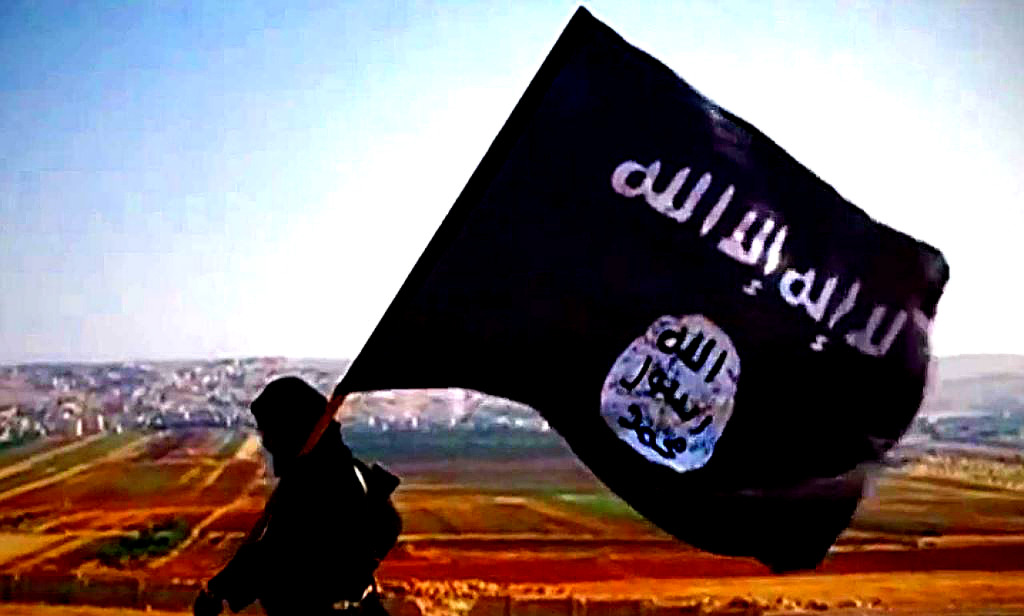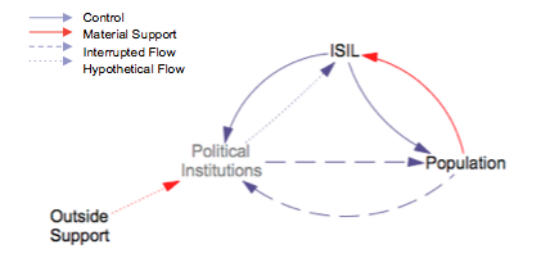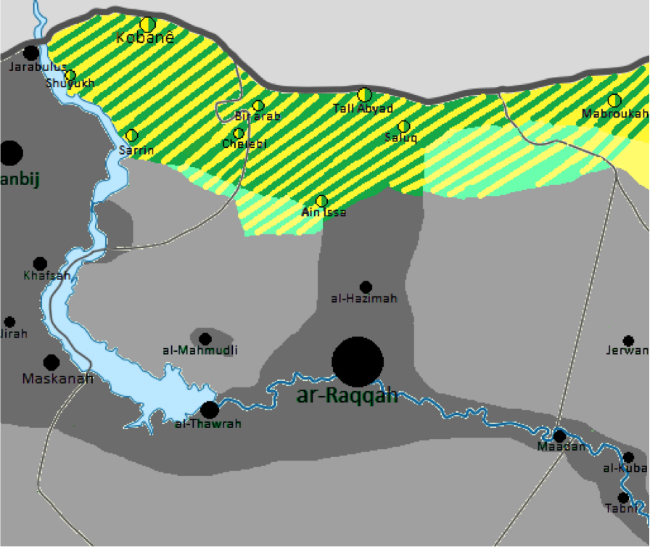The Case for a “Raqqa First” Strategy Against the Islamic State

May and June of 2015 brought a welcome streak of positive news from the war against the Islamic State in Iraq and the Levant (ISIL). The Kurdish People’s Protection Units (YPG) and their allies, including international coalition air support, made rapid gains in the countryside and villages of northern Raqqa, including Tel Abyad, the major settlement under ISIL control at the Turkish border. Coming weeks after ISIL’s seizure of the Iraqi city of Ramadi, the campaign to retake Tel Abyad demonstrated that ISIL’s aura of invincibility means little in open terrain against a disciplined ground force. Beyond merely demonstrating the potential for successful ground operations against ISIL, however, events in Raqqa also presented an important opportunity to consider the challenges and opportunities for post-liberation reconstruction and the mobilization of local forces against ISIL.
Since ISIL’s rapid growth in territorial control and military power in Iraq and Syria in 2013–2014, the group has focused on suppressing internal threats by attacking Sunni groups that pose a challenge to its political and military authority. ISIL’s efforts have been largely effective. At this time, there is little to no resistance to ISIL’s authority within areas it holds, despite the population’s discontent with the group. Frustrated about the lack of internal resistance, outside actors often avoid the question of mobilizing shattered and suppressed local institutions into a post-ISIL order, or else harbor overly ambitious views of the role of local opposition to ISIL by pushing for local revolts that would be suicidal under present conditions. ISIL’s grip on the local political order is not irreversible: Tribes and other local groups will emerge as an anti-ISIL force in the aftermath, but only if ISIL can be cleared to create the conditions for local resistance to emerge.
A clear-eyed assessment of ISIL’s current system of political control makes it clear that the most likely challenge to its dominance will come from the loss of territory north of Raqqa city. If that is the case, there are ways that outside powers can encourage and solidify anti-ISIL mobilization in order to use newly liberated areas as a beachhead for further territorial gains.
Our analysis here is based on the City As a System Analytical Framework, which guided an assessment of major ISIL-held areas in Raqqa and Mosul. The approach, developed over the last 18 months by Caerus Associates, focuses on the relationships between different parts of urban environments, placing particular attention on the flow of materials, people, and information (see postscript). Here we focus on the question of political resistance — a concern central to U.S. strategy in both Iraq and Syria. The tools in the Framework identify key elements of ISIL’s approach and highlight possible opportunities in Raqqa province.
The Islamic State’s Repressive Consolidation of its Rule
ISIL has targeted social and political organizations across Iraq and Syria, including tribal leaders, other insurgents, the traditional religious establishment, and the Iraqi government and Syrian regime. The group does this to neutralize the nodes around which internal dissent might accumulate legitimacy and form resistance. As ISIL has grown in size and strength, the number of its potential competitors for political legitimacy has shrunk substantially. In contrast to the environmental centers of gravity — including military, economic, and ground lines of communication — that ISIL has buttressed, the group has targeted through repressive political policies a center of gravity in order to deny a potential advantage to its adversaries and further consolidate its control.
Our research indicates that Mosul’s potential opposition is weak and disorganized with limited appeal even within the city, while Raqqa city has virtually no organized opposition. What opposition does exist is highly localized, in part because of the lack of extant, non-ISIL shared political and social institutions between different ISIL-held areas. Looking at the problem system as a whole reveals strikingly few social or political actors outside of ISIL’s ranks.
Before and immediately after it took over Mosul and Raqqa, ISIL attacked traditional social and political roles of tribal leaders in the areas under its control. While tribal affiliation is less salient in Mosul and Raqqa themselves, in the surrounding countryside tribes have played an important social and occasionally political role. In Iraq, ISIL targeted political leaders, many of whom were a part of the Awakening Movement, continuing a longstanding effort to weaken alternative political authorities. During that time, ISIL collected enough intelligence on key players who may challenge it in these areas to force local and national officials to collaborate with them. Shortly after gaining control over these areas, ISIL compelled the majority of armed groups and tribes to declare their allegiance to ISIL or, absent allegiance, completely withdraw from any independent political activities in ISIL-held areas. ISIL has forced leaders in the provinces of Mosul, Salahuddin, Anbar, Raqqa, and Deir ez-Zour to publicly declare their loyalty to ISIL and, in some cases, serve as its agents. In cases in which ISIL suspected outright opposition, it harassed, displaced, and even executed local leaders. In ISIL-held rural areas, where tribes participated in the Awakening Movement in 2006–2007, ISIL kidnapped and killed scores of leaders to neutralize their potential threat to its authority. In Deir ez-Zour, ISIL humiliated, killed, and displaced thousands of tribesmen in response to failed revolts. For those tribal leaders who fled, ISIL destroyed their homes and confiscated their land.

ISIL also removed, displaced, and murdered local religious leaders and imams who offered opposition to ISIL’s religious authority as a part of its efforts to create a monopoly over the religious establishment.
While ISIL initially cooperated with potential rivals from nationalist groups to Islamist armed groups shortly after gaining control, it forced them to disband or declare allegiance to it. For example, in Mosul, ISIL immediately attacked and detained dozens of former senior Ba’athists, most of whom had been military officers. Similarly in Syria, ISIL co-opted Salafist Islamist groups such as Ansar al-Islam through violence and intimidation.
ISIL also disbanded, disarmed, and imposed a strict surveillance system on former Iraqi Security Forces (ISF) and other potential sources of opposition, such as Iraqi local police in Mosul, Syrian regime army veterans, and local armed groups in Raqqa. ISIL forced these people to register their names and addresses in shari’a courts and go through shari’a courses. Although ISIL ensured that Iraqi and Syrian state institutions were completely disbanded, they allowed the majority of public servants to continue their work after going through shari’a courses, thus making their continued receipt of continued central government salary payments contingent on running critical infrastructure for ISIL.
By violently suppressing the influence of social and political actors in and around Mosul, ISIL decreased the capacity of political organizations to stage an internal rebellion, leaving the group unchallenged from within. By suppressing local political voices, ISIL was better able to integrate Mosul into its territorial holdings. Suppression also reinforces ISIL’s control over its internal lines of communication, which run through areas historically dominated by tribal actors.
There is an active clandestine resistance movement in Mosul, but there is little indication the group has the resources to effectively displace ISIL, the broad local support to mobilize or govern the city, or the inclination or capability to effectively coordinate with the central government of Iraq. The political environment around Mosul complicates efforts to foment resistance to ISIL from within the city. Aspiring units formed from the ranks of displaced Mosul residents lack cohesion and trust. Peshmerga forces attempting to isolate Mosul lack the motivation or political ties to mobilize or effectively coordinate with the Arab majority, and the prospects for an ISF offensive in the foreseeable future seem dim. While Mosul’s fall spurred the creation of an anti-ISIL coalition, this should not make Mosul an overriding focus if the conditions for liberation and reconstruction are not at hand. Armed and political groups have not been able to seriously challenge ISIL, and the current efforts by these groups are unlikely to yield widespread and successful armed resistance against ISIL.
The Case for Raqqa: Opportunities and Implications
Although ISIL’s efforts in the past three years have been highly repressive, they have not totally stamped out opposition groups, which remain latent, waiting for the situation to change so they can re-emerge. Thus, it is important to note where these groups are likely to re-emerge and where their presence can be leveraged. Although much has been said about liberating Mosul, the prospects for an offensive to retake the city seem distant at best. The ISF and its militia allies already lack the manpower for their ongoing offensive in Anbar. Bayji, located along a critical line of communication to Mosul, remains divided despite over a year of sustained combat. None of the various Kurdish forces in northern Iraq have been able to displace ISIL from Sinjar and Tal Afar, and even if they were successful, they are neither willing nor able to retake Mosul themselves. It is far more likely that ISIL will lose it holdings surrounding Raqqa before Mosul. How will this affect centers of potential resistance?
Our research identified possibilities to expand upon initial victories and degrade ISIL forces in Raqqa province and the wider region. Anti-ISIL forces can displace ISIL from key approaches surrounding Raqqa city, although progress may be limited at first. Strengthening centers of resistance will hurt ISIL’s influence locally and, to a limited extent, across ISIL’s broader territory. Although losing these areas will not defeat ISIL, even within Raqqa province, the loss will cost this violent proto-state a significant amount of legitimacy and authority in northern portions of Syria.
Scenarios of Liberation
Although ISIL continues to make gains in other fronts of Iraq and Syria, it is slowly but steadily losing the fight against the YPG and their allied armed groups in Raqqa, especially in rural areas. The YPG’s cohesive military forces and U.S.-led coalition airstrikes significantly reduced ISIL’s ability to conduct large counteroffensives in Raqqa to retake recently lost territories. Tribal areas west of Ain Essa and south of Tel Abyad, where key lines of communication (LOCs) are used by ISIL, may fall to YPG and their allies in the coming months (The current state of control is illustrated in Figure 2).

The loss of areas to the north and west of Raqqa city provides critical opportunities to further degrade ISIL capabilities within Raqqa and across ISIL’s broader holdings. Militarily, ISIL’s ability to leverage its highly mobile units depends on freedom of action in the countryside between battlefronts. Losing territories north of Raqqa city will shrink ISIL’s access to key LOCs that enable it to conduct hit-and-run offensive operations in the northern portion of the province. More importantly, ISIL’s pressure on political and social organizations will be lifted in the areas it loses, which is likely to result in these groups resurfacing and reassuming their role in the post-ISIL environment.
Resumption of Political E-COGs
If ISIL is removed from Raqqa’s northern and western surrounding areas, tribes, armed opposition groups, and civil society organizations will resurface as major political players, as illustrated in Figure 3. For example, on July 28, 2015, several local tribes joined Burkan al-Furat Operations Room in Tel Abyad, weeks after ISIL was removed from the area.

These groups will play an essential role in rebuilding, defending, and strengthening the anti-ISIL force, but also have strong potential to spoil peace in the area.
Local groups, including tribes and armed groups, are unlikely to instigate a resistance movement without significant and meaningful intervention and assistance from the outside. ISIL suppression such as exiling and killing key leaders or disarming the local population has left local political groups with fewer means of resistance. As the diagram above shows, encouraging resistance against ISIL in these areas requires significant support from outside parties. While ISIL relies on internal generation of revenue across a huge territory, tribes and local armed groups, at least in the first stages of their anti-ISIL efforts, will be unlikely to be able to sustain themselves. They are more likely to look outward for military and financial support, whether from other armed groups, such as the YPG, Jabhat al-Nusra, or Ahrar al-Sham, or directly from Turkey or the United States. Because of the conflicting agendas of these actors, determining who and how local actors will be integrated into reconstruction institutions should precede offensive operations rather than serve as an afterthought to military advances.
It is important to note that the handover of these areas from one authority to another has damaged the traditional leadership of tribes. Many tribal leaders have given their allegiance to ISIL, left the area, or been killed. As a result, it is likely that these leaders have lost a significant amount of their influence over their tribesmen. Thus, anti-ISIL forces should seek to find or create new leadership able to rally their tribesmen.
Tribes in rural areas in Raqqa can play a key role in the post-ISIL environment. If given the needed resources and political support, tribes can block ISIL’s access to their areas, making them an attractive environmental center of gravity (E-COG) around which to mobilize resistance and deny ISIL access to key lines of communications. These tribes may also form resistance to the occupying forces, even if that force is Syrian in composition. Despite the YPG’s stated efforts to allay ethnic tensions in liberated areas, anti-YPG sentiment is common enough among local Arabs and armed Arab opposition groups to raise the costs and risks of a YPG-dominated liberation of Arab areas. Thus, it will be essential to the occupying force to form a thorough understanding of these groups to gain their support.
Lessons learned from the Iraqi Awakening Movement can provide a guide to best practices to empower tribal authorities. Tribal elements should have a major role in governing and securing their areas. The use of an incentive-based system can assist the YPG and their allies to gain support among these tribes. Allocating reconstruction funds to meet local needs and reward and strengthen local power-holders can be one tool to gain support and influence over tribes as well as to further empower them. Participation and reward is likely to play a key role in keeping any future structure resistant to internal and external pressures.
At the same time, ISIL’s removal will open space for armed opposition groups with historic local ties in Raqqa who may play a spoiling role to the occupying force to reestablish a presence in the area, especially Ahrar al-Sham and Jabhat al Nusra. Both groups have strong relations with the local populations and had operated in the province before ISIL’s takeover. Ahrar al-Sham and Jabhat al-Nusra are likely to attempt to spoil the efforts of either rival groups or the YPG to establish strong relations with the local population. Mismanagement and rivalry among local social and political organizations in the area can be a reentry venue for these groups.
Although Turkey has opened Incirlik to U.S. aircraft conducting airstrikes on ISIL and declared intentions to create an ISIL-free buffer zone along the border in Aleppo province, events in the would-be buffer zone combined with Turkey’s approach toward the YPG and the PKK complicate scenarios for the liberation of Raqqa. Groups such as Ahrar al-Sham and Jabhat al-Nusra stand to gain the most if they can displace ISIL from such a zone. Replicating that notional model in northern Raqqa would openly endanger the YPG, while Turkey is unlikely to support efforts to liberate Raqqa that entrench the YPG’s position.
Empowering groups with negative relations with local groups, and with no willingness to reconcile, may ignite competition and rivalry. Ensuring local residents have a meaningful role in governing their areas and managing relations among the different competing groups will be essential to keep the influence of groups such as Jabhat al-Nusra and Ahrar al-Sham in check. If the occupying force fails to manage and mitigate inter-tribal conflict in a post-ISIL environment, spoiling actors are likely to have the advantage.
Looking Forward
Without an effort to reconstitute local political institutions and armed actors willing to support them in the Raqqa countryside, gains made in one of ISIL’s more vulnerable fronts may prove tenuous. Raqqa presents opportunities overlooked by many of the prevailing approaches to the region. While Iraq may provide more opportunities for the coalition to support local anti-ISIL actors on a large scale, these efforts — especially if they face diminishing returns — should not distract from opportunities in Raqqa that could have regional ramifications against ISIL. Although the policy framing and military operations of many actors in the anti-ISIL effort plan campaigns and measure victory in terms of major population centers taken, denying ISIL not just control but freedom of action in the countryside is key to severing the LOCs that sustain its theater-wide offensive and defensive efforts. Nor should assessment of the prospects for local actors to hold and administer liberated territory take a backseat to the more straightforward task of displacing ISIL.
The disasters that have befallen many U.S.-aligned groups in Syria, such as Harakat Hazzm or Division 30 highlight the difficulties of attempting to establish allied footholds without consideration of the environment. Although Jabhat al-Nusra and Ahrar al-Sham no longer have a dominant influence in Raqqa, if they fill the vacuum left in ISIL’s wake, then efforts to create a coalition-aligned local force after the fact could meet a similar end. Similarly, in light of increasing conflict between Turkey and the PKK, simply relying on the YPG to fulfill these roles will prove increasingly infeasible the further into Raqqa anti-ISIL forces advance.
The displacement of ISIL forces from more of Raqqa’s countryside or even Raqqa city would not deal ISIL a deathblow, but it would severely impede its internal lines and thus disrupt its military operations and economic flows across multiple fronts. Although this approach would be slower and highly localized by nature, an emphasis on building local anti-ISIL opposition in the Raqqa countryside could have outsized effects compared to the proposed buffer zone in northern Aleppo or sputtering offensive operations in Iraq. Yet as infighting between Islamist and U.S.-aligned opposition groups and Turkey’s new campaign against the PKK demonstrate, the conditions to take advantage of such an opportunity may not be around forever.
Daniel Trombly is an analyst focusing on illicit networks and clandestine organizations, most recently supporting multiple projects at Caerus Associates.
Yasir Abbas is an analyst with The Stabilization Network (TSN), a Washington, DC-based C-VE and conflict stabilization consultancy. Prior to his work with with TSN, Yasir served as an interpreter and adviser with the U.S. Army in Iraq between 2005 and 2009 where he assisted in organizing the Awakening Movement in the Taji area north of Baghdad.
Postscript: City As a System Analytical Framework Process
The City As a System Analytical Framework consists of three primary steps: 1) Define the Urban Operational Environment, 2) Frame and Map Urban Problem Systems, and 3) Develop and Analyze Courses of Action (COAs).
Step 1 of the Framework produces an understanding of the current and historical state of the operational environment by defining significant characteristics of the urban environment using an ontology, then extending research to fill identified intelligence gaps using the Urban Triad framework of population, infrastructure, and terrain. Step 2 of the Framework focuses on identifying the elements of the problem system posed by ISIL’s control over major urban centers. This involves the Framework’s FASCOPE (Flows plus the Civil Affairs ASCOPE — Areas, Structures, Capabilities, Organizations, People, and Events) tool to identify problem system elements as different types of flows, nodes, and accumulators. Finally, Step 3 calls for the identification of environmental centers of gravity (E-COGs) — that is the critical elements that enable or buttress the system as a whole. This expands on traditional, enemy-centric center of gravity analysis and allows for a holistic systems analysis of all the elements in the operating environment.

